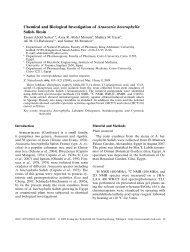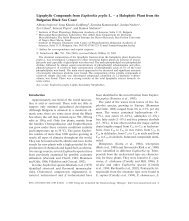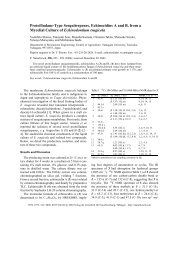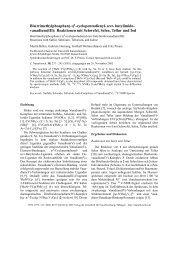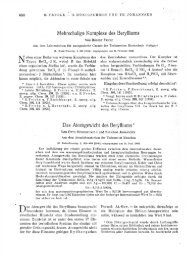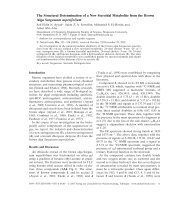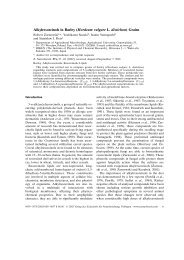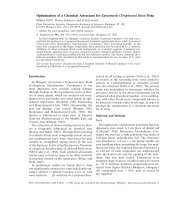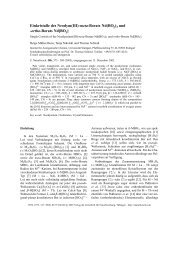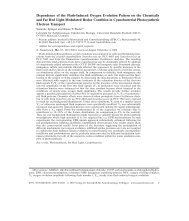Synthesis, Properties and Dimerization Study of Isocyanic Acid
Synthesis, Properties and Dimerization Study of Isocyanic Acid
Synthesis, Properties and Dimerization Study of Isocyanic Acid
You also want an ePaper? Increase the reach of your titles
YUMPU automatically turns print PDFs into web optimized ePapers that Google loves.
<strong>Synthesis</strong>, <strong>Properties</strong> <strong>and</strong> <strong>Dimerization</strong> <strong>Study</strong> <strong>of</strong> <strong>Isocyanic</strong> <strong>Acid</strong><br />
Gerd Fischer, Janna Geith, Thomas M. Klapötke, <strong>and</strong> Burkhard Krumm<br />
Department <strong>of</strong> Chemistry, University <strong>of</strong> Munich (LMU),<br />
Buten<strong>and</strong>tstrasse 5 - 13 (D), D-81377 Munich, Germany<br />
Reprint requests to Pr<strong>of</strong>. Dr. Th. M. Klapötke. Fax: +49 (0)89 2180 7492.<br />
E-mail: tmk@cup.uni-muenchen.de<br />
Z. Naturforsch. 57b,19–24 (2002); received September 21, 2001<br />
<strong>Isocyanic</strong> <strong>Acid</strong>, Dimeric <strong>Isocyanic</strong> <strong>Acid</strong><br />
<strong>Isocyanic</strong> acid was prepared in pure form by reaction <strong>of</strong> KOCN or NaOCN with stearic<br />
or oxalic acid in good yield. Identification, characterization <strong>and</strong> investigation <strong>of</strong> the thermal<br />
stability <strong>of</strong> HNCO <strong>and</strong> evidence for a possible existence <strong>of</strong> “dicyanic acid” have been studied in<br />
gas phase, liquid <strong>and</strong> solid state by vibrational <strong>and</strong> NMR spectroscopy <strong>and</strong> mass spectrometry.<br />
1. Introduction<br />
In an 1830 publication J. Liebig <strong>and</strong> F. Wöhler<br />
[1] first reported on the preparation <strong>of</strong> isocyanic<br />
acid, which later was improved by A. Baeyer [2].<br />
The preparation <strong>and</strong> properties <strong>of</strong> HNCO <strong>and</strong> some<br />
<strong>of</strong> its derivatives have been described in the literature<br />
[3, 4]. The polymerization <strong>of</strong> HNCO leads<br />
to a mixture <strong>of</strong> cyanuric acid (trimer <strong>of</strong> HNCO)<br />
<strong>and</strong> cyamelide [3, 5]. Cyanuric acid is a commercially<br />
available substance [3, 6]. However, there has<br />
been some doubt regarding the thermal stability <strong>of</strong><br />
HNCO <strong>and</strong> possible formation <strong>of</strong> dimers or other<br />
oligomers with the formula (HNCO)n [7].<br />
<strong>Isocyanic</strong> acid forms very strong hydrogen bonds,<br />
therefore the formation <strong>of</strong> dimers is possible. These<br />
dimers should have b<strong>and</strong>s in the same region as the<br />
1 fundamental <strong>of</strong> monomeric HNCO [8]. Owing<br />
to a formal analogy between isomeric cyanic acid:<br />
HN=C=O À HO-C=N (1)<br />
<strong>and</strong> that <strong>of</strong> cyanamide:<br />
HN=C=NH À H2NC=N (2)<br />
attempts have been made to prepare a dimeric form<br />
<strong>of</strong> HNCO, which would bear the same relationship<br />
to dimeric cyanamide, as in the case for the trimers<br />
cyanuric acid <strong>and</strong> melamine [7].<br />
Ponsgen [9] had reported about the existence <strong>of</strong><br />
“dicyanic acid”, but it was later shown by Hallwachs<br />
[10], that this substance was impure cyanuric acid.<br />
Schmidt [11] also claimed to have prepared a small<br />
amount <strong>of</strong> (HNCO)2 by the treatment <strong>of</strong> triuret<br />
with excess phosgene, but the presented evidence<br />
by Schmidt is questionable. Another attempt for a<br />
preparation <strong>of</strong> (HNCO)2 by decomposition <strong>of</strong> both<br />
nitrourea <strong>and</strong> nitrobiuret in aqueous <strong>and</strong> alcoholic<br />
solutions was published by Davis <strong>and</strong> Blanchard<br />
[12] according to the following equation:<br />
2 HN=C=O H2NC(O)N=C=O (3)<br />
However, isolation <strong>of</strong> this material failed due to<br />
complete hydrolysis during evaporation.<br />
On the other h<strong>and</strong>, thiodicyanic acid, H2NC(O)N<br />
=C=S, was obtained in good yield by the reaction <strong>of</strong><br />
HNCO <strong>and</strong> HNCS in ethereal solution at 0 C[13].<br />
This compound can be heated up to 105 C before<br />
undergoing decomposition. The dimer <strong>of</strong> HNCS<br />
was prepared by passing HCl through an aqueous<br />
solution <strong>of</strong> KSCN [14].<br />
In a theoretical study [15] it was found that the<br />
reaction:<br />
2 HN=C=O HN=C=NH + CO2 (4)<br />
is less favorable than the dimerization <strong>of</strong> HNCO to<br />
give (HNCO)2 <strong>of</strong> C2v symmetry.<br />
In view <strong>of</strong> the theoretical investigation <strong>of</strong> the<br />
polymerization pathways <strong>of</strong> isocyanic acid we<br />
have performed semi-empirical (PM3/VSTO-3G(d)<br />
method) <strong>and</strong> ab initio HF <strong>and</strong> MP2 calculations employing<br />
the 6-31G(d,p) basis set [16]. It was found<br />
that the polymerization <strong>of</strong> HNCO to oxo (keto) cyanuric<br />
acid is thermodynamically the most favorable.<br />
The dimeric HNCO (keto-structure <strong>of</strong> C2v symmetry)<br />
is the favored compound at all the levels <strong>of</strong><br />
theory applied.<br />
0932–0776/02/0100–0019 $ 06.00 c 2002 Verlag der Zeitschrift für Naturforschung, Tübingen Á www.znaturforsch.com K
20 G. Fischer et al. · <strong>Synthesis</strong>, <strong>Properties</strong> <strong>and</strong> <strong>Dimerization</strong> <strong>Study</strong> <strong>of</strong> <strong>Isocyanic</strong> <strong>Acid</strong><br />
Fig. 1. Vibrational spectra <strong>of</strong> HNCO: IR spectrum <strong>of</strong><br />
HNCO gas at 25 C <strong>and</strong> Raman spectrum <strong>of</strong> solid HNCO<br />
at –80 C.<br />
2. Results <strong>and</strong> Discussion<br />
2.1. <strong>Synthesis</strong><br />
The preparation <strong>of</strong> HNCO has been reported by<br />
several research groups [3, 4]. The methods reported<br />
here represent optimized literature procedures [4]<br />
(eq. (5)) using stearic acid <strong>and</strong> a new alternative<br />
procedure with oxalic acid for the preparation <strong>of</strong><br />
HNCO in good yield (eq. (6)):<br />
MOCN + R-COOH HNCO + R-COOM (5)<br />
(M = Na, K; R = C17H35)<br />
2 MOCN + (COOH)2 2 HNCO + (COOM)2 (6)<br />
(M = Na, K)<br />
Liquid isocyanic acid can be stored at –78 C without<br />
decomposition at least for 5 days. <strong>Isocyanic</strong><br />
acid is a gas at room temperature (b. p. 24 C) <strong>and</strong><br />
behaves much like ketene; its tendency to form hydrogen<br />
bonds leads to the possible formation <strong>of</strong><br />
dimers. In this regard we have investigated the stability<br />
<strong>of</strong> HNCO in the gas, liquid <strong>and</strong> solid state by<br />
vibrational <strong>and</strong> NMR spectroscopy, as well as mass<br />
spectrometry in the temperature ranges between –80<br />
<strong>and</strong> 160 C (see below).<br />
2.2. Vibrational spectra<br />
The structure <strong>of</strong> HNCO has been established by<br />
many infrared <strong>and</strong> Raman studies [17]. The dimers<br />
should have b<strong>and</strong>s in the same region as the 1<br />
fundamental <strong>of</strong> the HNCO-monomer [8]. To our<br />
knowledge, prior to this study, there had been no<br />
reports on the investigation <strong>of</strong> gas phase stability<br />
(temperature dependence, with or without presence<br />
Fig. 2. Temperature dependent IR spectra <strong>of</strong> gas phase<br />
HNCO at 80, 110, 130, 150 <strong>and</strong> 160 C.<br />
Fig. 3. IR spectra by cooling gas phase HNCO from<br />
160 Cto25 C.<br />
<strong>of</strong> N2)<strong>of</strong>HNCOupto160 C <strong>and</strong> possible formation<br />
<strong>of</strong> dimers by (high-temperature) gas phase FT-IR<br />
spectroscopy.<br />
While the spectra <strong>of</strong> HNCO are well investigated<br />
<strong>and</strong> understood, there remain some unclear points<br />
in the spectra <strong>of</strong> its derivatives [8, 17]. The IR spectrum<br />
<strong>of</strong> HNCO in the gas phase is very complex<br />
because <strong>of</strong> its quasilinearity. HNCO belongs to Cs<br />
point group with six vibrational fundamentals, but<br />
only four <strong>of</strong> these six can be found [17].<br />
The IR spectrum <strong>of</strong> gas phase HNCO at 25 C<br />
<strong>and</strong> the Raman spectrum <strong>of</strong> solid isocyanic acid at<br />
–80 C are shown in Fig. 1. Experimental wavenumbers<br />
are in good agreement with literature data<br />
[8, 17].<br />
The most intense <strong>and</strong> characteristic absorption<br />
peak in the FT-IR spectrum <strong>of</strong> HNCO gas is the<br />
b<strong>and</strong> at 2259 cm À1 (asNCO), the most intense b<strong>and</strong><br />
in the Raman spectrum is the b<strong>and</strong> at 1323 cm À1<br />
(sNCO). The comparison <strong>of</strong> the infrared spectrum<br />
<strong>of</strong> HNCO vapor with that at low temperature in the
G. Fischer et al. · <strong>Synthesis</strong>, <strong>Properties</strong> <strong>and</strong> <strong>Dimerization</strong> <strong>Study</strong> <strong>of</strong> <strong>Isocyanic</strong> <strong>Acid</strong> 21<br />
condensed phase shows that free HNCO in the gas<br />
phase consists <strong>of</strong> HNCO monomers.<br />
The thermal behavior <strong>of</strong> HNCO in the gas phase<br />
measured with a heating rate <strong>of</strong> ca. 10 CÁmin À1 is<br />
shown in Fig. 2 (heating) <strong>and</strong> Fig. 3 (cooling).<br />
By varying the time between 0 und 140 min <strong>and</strong><br />
the temperature from 25 up to 160 C (Fig. 2), with<br />
or without N2, it was found, that up to 80 C only<br />
HNCO itself was present in the gas phase. At temperatures<br />
higher than 80 C in the FT-IR spectrum<br />
HNCO, CO2 <strong>and</strong> NH3 are the only products observed.<br />
The formation <strong>of</strong> CO2 <strong>and</strong> NH3 is probably<br />
the result <strong>of</strong> the reaction <strong>of</strong> HNCO with traces <strong>of</strong><br />
water vapor:<br />
(HN=C=O - N=COH) + H2O NH3 +CO2 (7)<br />
NMR spectra<br />
The NMR spectra <strong>of</strong> isocyanic acid were<br />
recorded in CDCl3 solution. At 25 Cthe 1 HNMR<br />
resonance, a triplet, is found at = 3.74 with a coupling<br />
constant <strong>of</strong> 1 JH- N = 67.0 Hz, which is in<br />
good agreement with the previously reported value<br />
<strong>of</strong> 64 Hz [18b]. Upon cooling to –60 C the triplet<br />
collapses to a broadened singlet, whereas the triplet<br />
still exists after rapid heating to 60 C. The 13 C<br />
NMR spectrum <strong>of</strong> HNCO at 25 C, shown in Fig. 6,<br />
reveals also coupling to the 14 N nucleus.<br />
The resonance at = 131.7 is nicely distinguishable<br />
from a trace <strong>of</strong> CO2 by its (broadened) triplet<br />
fine structure with a coupling <strong>of</strong> 1 JC- N = 19.2 Hz.<br />
Fig. 4. 13 C NMR spectrum <strong>of</strong><br />
HNCO in CDCl3 at 25 C.<br />
Again, this triplet collapses at lower temperatures.<br />
The resonance for CO2 at = 124.7 was confirmed<br />
by an authentic sample <strong>of</strong> CO2 in CDCl3. Thenitrogen<br />
NMR spectra at –30 C show singlets. The<br />
14 N resonance in CDCl3 is relatively sharp at =<br />
–357 with a half-line width <strong>of</strong> 60 Hz. The 15 N NMR<br />
spectrum was recorded as neat liquid at –30 C <strong>and</strong><br />
ashift<strong>of</strong> = –356.6 was observed. The recording <strong>of</strong><br />
the 15 N NMR spectrum at higher temperatures (already<br />
0 C) caused significant decomposition. In all<br />
NMR spectra no evidence for a possible existence<br />
<strong>of</strong> a dimer <strong>of</strong> HNCO was detected.<br />
2.4. Mass spectra<br />
Mass spectrometry <strong>of</strong> HNCO has been performed<br />
by several groups [19], but to our knowledge only<br />
in the electron ionization (EI) mode. The thermal<br />
behaviour <strong>of</strong> HNCO <strong>and</strong> the possible existence <strong>of</strong><br />
(HNCO)2 have not successfully been studied using<br />
mass spectrometric analysis. Mass spectra <strong>of</strong><br />
HNCO <strong>and</strong> its polymer contain a number <strong>of</strong> both<br />
fragment <strong>and</strong> molecular ions. This makes identification<br />
difficult, especially when the polymer can be<br />
a mixture <strong>of</strong> some unknown substances [3, 20]. In<br />
this study we would like to introduce the use both <strong>of</strong><br />
EI <strong>and</strong> chemical ionization (CI) mass spectrometry<br />
for the study <strong>of</strong> the thermal behaviour <strong>of</strong> HNCO.<br />
The EI mass spectrum <strong>of</strong> pure HNCO vapor at<br />
–40 C is shown in Table 1 <strong>and</strong> Fig. 5 <strong>and</strong> is in<br />
agreement with [19]. The molecular peak <strong>of</strong> HNCO
22 G. Fischer et al. · <strong>Synthesis</strong>, <strong>Properties</strong> <strong>and</strong> <strong>Dimerization</strong> <strong>Study</strong> <strong>of</strong> <strong>Isocyanic</strong> <strong>Acid</strong><br />
Table 1. EI-mass spectrum (70 eV) <strong>of</strong> HNCO vapor at<br />
–40 C.<br />
Mass Relative Assign- Mass Relative Assignintensity<br />
ment intensity ment<br />
12 0.7 C +<br />
14 0.7 N +<br />
15 4.2 NH +<br />
16 0.2 O +<br />
21.5 0.7 HNCO 2+<br />
26 1.9 CN +<br />
27 1.8 CNH +<br />
28 4.5 CO + /N2 +<br />
29 14.2 COH +<br />
30 1.3 NO +<br />
42 20.9 NCO +<br />
43 100 HNCO +<br />
(m/z 43; correct isotopic pattern) is the base peak<br />
<strong>and</strong> also the highest observable peak.<br />
After complete polymerization at room temperature,<br />
an EI mass spectrum was recorded. There were<br />
no non-condensable products except HNCO in the<br />
gas phase in any <strong>of</strong> these experiments. Fig. 6 shows<br />
the EI mass spectrum <strong>of</strong> the white solid polymer<br />
after complete polymerization at 25 C.<br />
The ion m/z 43is considered as ionized isocyanic<br />
acid. The ions at m/z 28 <strong>and</strong> 16 were considered as<br />
residual dinitrogen <strong>and</strong> oxygen, respectively. The<br />
m/z 129 coincides with the trimerization product<br />
Fig. 5. EI-mass spectrum (70 eV) <strong>of</strong><br />
HNCO vapor at –40 C.<br />
Fig. 6. The EI-mass spectrum <strong>of</strong> solid<br />
polymer after complete polymerization.<br />
(M + <strong>of</strong> cyanuric acid, the trimer <strong>of</strong> HNCO):<br />
3 HNCO (HNCO)3<br />
(8)<br />
The presence <strong>of</strong> ion m/z 17 (ammonia) <strong>and</strong> ion m/z<br />
44 (carbon dioxide) can be interpreted by reaction<br />
<strong>of</strong> HNCO with the residual water vapor [eg. (7)].<br />
The ion m/z 60 (M + <strong>of</strong> urea) can be understood<br />
by the reaction <strong>of</strong> ammonia with isocyanic acid:<br />
NH3 + HNCO (NH4)NCO (NH2)2CO (9)<br />
The peak at m/z 86 could possibly arise from the<br />
dimerization <strong>of</strong> HNCO:<br />
2 HNCO (HNCO)2<br />
(10)<br />
The CI-ammonia <strong>and</strong> isobutane spectra <strong>of</strong> the polymer<br />
were recorded as follows:<br />
CI (isobutane): m/z = 130 ((HNCO)3 +H + )),<br />
100%; m/z = 104 (biuret + H + ), 10%; m/z =87<br />
((HNCO)2 + H + )), 44%; m/z = 86 ((HNCO)3-<br />
HNCO + )), 4%; m/z =61(urea+H + ), 78%.<br />
The base peak at m/z 129 can be interpreted<br />
by trimerization <strong>of</strong> HNCO to cyanuric acid. Exact
G. Fischer et al. · <strong>Synthesis</strong>, <strong>Properties</strong> <strong>and</strong> <strong>Dimerization</strong> <strong>Study</strong> <strong>of</strong> <strong>Isocyanic</strong> <strong>Acid</strong> 23<br />
mass by HR: calcd. 129.0174, found: 129.0165<br />
(–1.0 mmu).<br />
The peaks at m/z43, 44 <strong>and</strong> 60 are considered being<br />
isocyanic acid, CO2 <strong>and</strong> urea, respectively. The<br />
detection <strong>of</strong> ion m/z 103 (probably biuret) supports<br />
in part the decomposition reaction <strong>of</strong> HNCO.<br />
These results suggest that several polymerization<br />
reactions <strong>and</strong> the simple decomposition reaction occur<br />
simultaneously. It is remarkable that authentic<br />
cyanuric acid, measured under identical conditions,<br />
exhibits neither a peak at m/z 86, nor at 87, which<br />
is more intense than 1%.<br />
Therefore it can be concluded that m/z 86 or<br />
m/z 87 do not represent fragment ions <strong>of</strong> cyanuric<br />
acid, but dimerization product <strong>of</strong> isocyanic acid,<br />
(HNCO)2. This is strongly supported by high resolution<br />
measurements <strong>of</strong> the polymer: m/z 86.0109<br />
(–0.7 mmu); calcd. for H2N2C2O2 m/z 86.0116.<br />
3. Experimental Section<br />
3.1. Preparation <strong>and</strong> purification<br />
First method: The preparation <strong>of</strong> HNCO was carried<br />
out by the reaction <strong>of</strong> one equivalent <strong>of</strong> purified anhydrous<br />
potassium or sodium cyanate with two equivalents <strong>of</strong> dry<br />
stearic acid. The reagents were heated under vacuum but<br />
in contrast to [4] at 130 C. Gaseous HNCO was passed<br />
through a tube filled with P4O10 <strong>and</strong> collected in a liquid<br />
nitrogen trap. Yield: 70%.<br />
Second method: This is a similar procedure as above,<br />
except using oxalic acid. In this method, which has not<br />
been previously described, the reagents were heated in<br />
vacuo under anhydrous conditions <strong>and</strong> the reaction products<br />
were collected in a liquid nitrogen trap. Repeated<br />
trap-to-trap distillation in vacuo reduced the impurities<br />
(most CO2) to less than 1%. This was estimated by vibrational<br />
<strong>and</strong> NMR spectroscopy as well as mass spectrometry<br />
investigations. Yield: 65%.<br />
[1] J. Liebig, F. Wöhler, Ann. Phys. 20, 394 (1830).<br />
[2] A. Baeyer, Liebigs Ann. Chem. 114, 165 (1860).<br />
[3] Gmelin, System Nr. 14, (1971), pp 327, 366.<br />
[4] a) M. Linhard, Z. Anorg. Allg. Chem. 239, 200<br />
(1938); b) G. T. Fujimoto, M. E. Umstead, M. C.<br />
Lin, J. Chem. Phys. 65, 197 (1982); c) M. Zyrianov,<br />
T. Droz-Georget, A. Sanov, H. Reisler, J. Chem.<br />
Phys. 105, 8111 (1996).<br />
[5] a) A. Senier, C. Walsh, J. Chem. Soc. 81, 290 (1908);<br />
b)W.Kern,H.Paul,W.Mehren,J.Makromol.Chem.<br />
Ges. 38, 1013 (1954).<br />
3.2. Polymerization <strong>of</strong> HNCO<br />
Samples <strong>of</strong> liquid HNCO in a tube in vacuo were<br />
immersed in baths at 0 (ca. 1 d), 24 (ca. 1 h) <strong>and</strong><br />
100 C(ca. min). Upon complete polymerization, the<br />
gas phase IR <strong>and</strong> mass spectra were recorded. The polymer<br />
was extracted with hot water (80 C), <strong>and</strong>, after removal<br />
<strong>of</strong> the insoluble cyamelide, the filtrate concentrated.<br />
The collected crystalline material was dried at<br />
110 C. Elemental analysis for residue: Found C 27.8;<br />
N 33.6; H 2.8. Calcd (for cyanuric acid): C 27.9; N 32.6;<br />
H 2.3%.<br />
3.3. Spectroscopy<br />
The infrared spectra were obtained using KBr discs for<br />
the solids <strong>and</strong> a 10 cm cell equipped with KBr windows<br />
for the gases by means <strong>of</strong> a Perkin-Elmer IR Spectrum<br />
One spectrometer. Raman spectra were recorded on a<br />
Perkin-Elmer 2000 NIR FT-Raman spectrometer. NMR<br />
spectra were recorded both as CDCl3 solutions <strong>and</strong> neat<br />
HNCO using a JEOL Eclipse 400 instrument. Chemical<br />
shifts are with respect to (CH3)4Si ( 1 H<strong>and</strong> 13 C) <strong>and</strong><br />
CH3NO2 ( 14 N, 15 N). Mass spectra were obtained with<br />
a Jeol MStation JMS 700 gas inlet system (100 C).<br />
The source was operated at a temperature <strong>of</strong> 200 C,<br />
<strong>and</strong> the probe temperature was varied from –40 Cup<br />
to room temperature. In the EI mode the electron energy<br />
was 70 eV; in the CI mode alternatively ammonia <strong>and</strong><br />
isobutane were used as reagent gases. Elemental analysis<br />
was performed with a C,H,N-Analysator Elementar<br />
Vario El.<br />
Acknowledgements<br />
We would like to thank Mr. G. Spieß for assisting<br />
with IR <strong>and</strong> Raman measurements. Financial support for<br />
this work by Norsk Hydro ASA (Oslo), the University <strong>of</strong><br />
Munich, the Fonds der Chemischen Industrie <strong>and</strong> MAN<br />
(Nürnberg) is gratefully acknowledged.<br />
[6] Z. Qui, Z. Fang, M. Cheng, D. Zhao, J. Shiyou<br />
Huagong Xueyuan Xuebao 11, 56 (1999).<br />
[7] a) E. A. Werner, W. R. Fearon, J. Chem. Soc. 117,<br />
1326 (1920); b) A. E. A. Werner, J. Gray, Sci.<br />
Proc.Roy.DublinSoc.24, 209 (1947); c) E. Hayek,<br />
Monatsh. Chem. 96, 517 (1965).<br />
[8] J.A.Teles,G.Maier,B.A.Hess,L.J.Schaad,M.<br />
Winnewisser, B. P. Winnewisser, Chem. Ber. 122,<br />
753 (1989).<br />
[9] A. Ponsgen, Ann. Chem. 128, 345 (1863).<br />
[10] O. Hallwachs, Ann. Chem. 153, 293 (1870).
24 G. Fischer et al. · <strong>Synthesis</strong>, <strong>Properties</strong> <strong>and</strong> <strong>Dimerization</strong> <strong>Study</strong> <strong>of</strong> <strong>Isocyanic</strong> <strong>Acid</strong><br />
[11] P. Schmidt, J. Prep. Chem. 5, 35 (1872).<br />
[12] A. David, X. Blanchard, J. Am. Chem. Soc. 51, 1806<br />
(1929).<br />
[13] S. Birckenbach, Chem. Ber. 71, 1492 (1938).<br />
[14] a) A. Johnson, C. Hill, B. Bailey, J. Am. Chem. Soc.<br />
37, 2415 (1915); b) A. P. Antipov, Zh. Prikl. Khim.<br />
(Leningrad) 40, 2547 (1967).<br />
[15] F. Wen-Lin, W. Jan, Z. Shao-Wen, Theochem 342,<br />
147 (1995).<br />
[16] J. Geith, T. M. Klapötke,J.Mol.Str.(Theochem)<br />
538, 29 (2001).<br />
[17] a) M. W. Chase, NIST-JANAF Thermochemical<br />
Tables, Fourth Edition, J. Phys. Chem. Ref. Data,<br />
Monograph 9, 1-1951 (1998); b) C. Reid, J. Chem.<br />
Phys. 18, 1544 (1950); c) G. Herzberg, C. Reid,<br />
Discuss. Faraday Soc. 9, 92 (1950); d) R. N.<br />
Dixon, G. H. Kirby, Trans. Faraday Soc. 64, 2002<br />
(1968); e) H. Okabe, J. Chem. Phys. 53, 3507<br />
(1970); f) D. A. Steiner, K. A. Wishah, S. R. Polo,<br />
T. K. McCubbin, J. Mol. Spectrosc. 76, 341 (1979);<br />
g) B. Lemoine, K. Yamada, M. Winnewisser, Ber.<br />
Bunsenges. Phys. Chem. 86, 795 (1982); h) D. A.<br />
Steiner, S. R. Polo, T. K. McCubbin, K. A. Wishah,<br />
J. Mol. Spectrosc. 98, 453 (1983); i) L. Fusina,<br />
M. Carlotti, B. Carli, Can. J. Phys. 62, 1452 (1984);<br />
j) J. N. Crowley, J. R. Sodeau, J. Phys. Chem. 93,<br />
3100 (1989); k) K. M. T. Yamada, M. Winnewisser,<br />
J. W. C. Johns, J. Mol. Spectrosc. 140, 353 (1990);<br />
l) S. S. Brown, H. L. Berghout, F. F. Crim, J. Chem.<br />
Phys. 107, 9764 (1997).<br />
[18] a) J. N. Shoolery, R. G. Shulman, D. M. Yost,<br />
J. Chem. Phys. 19, 250 (1951); b) J. Nelson,<br />
R. Spratt, S. M. Nelson, J. Chem. Soc. A 4, 583<br />
(1970); c) K. M. Mackay, S. R. Stobart, Spectrochim.<br />
Acta. 27 A, 923 (1971).<br />
[19] a) J. P. Mui, R. A. Back, Can. J. Chem. 41, 826<br />
(1962); b) J. M. Ruth, R. J. Phillipe, Analyt. Chem.<br />
38, 720 (1966); c) S. R. Smith, H. B. Jonassen,<br />
J. Inorg. Nucl. Chem. 29, 860 (1967); c) D. J.<br />
Bogan, C. W. H<strong>and</strong>, J. Phys. Chem. 75, 1532<br />
(1971); d) F. Compernolle, Org. Mass. Spectrosc.<br />
10, 289 (1975); e) B. Ruscic, J. Berkowtiz, J. Chem.<br />
Phys. 100, 4498 (1994); f) M. Aigner, M. Zeilinger,<br />
H. H<strong>of</strong>bauer, Chem. Eng. Process. 34, 515 (1995);<br />
g) D. Karlsson, M. Dalene, G. Skarping, A. N. G.<br />
Mar<strong>and</strong>, J. Environ. Monit. 3, 432 (2001).<br />
[20] a) X. Cheng, Q. Gao, R. Smith, E. E. Simanek,<br />
M. Mammen, J. Org. Chem. 61, 2204 (1996);<br />
b) J. Chen, K. Isa, J. Mass Spectrom. Soc. Jpn.<br />
46, 299 (1998); c) D. M. Lewis, X. M. Shen, K. N.<br />
Tapley, Adv. Colour Sci. Technol. 4, 59 (2001).






